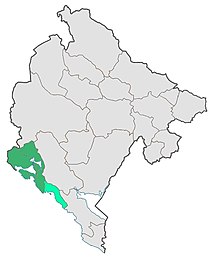
Back خليج كوتور Arabic Kotor körfəzi Azerbaijani Котарскі заліў Byelorussian Котарская затока BE-X-OLD Которски залив Bulgarian Boka kotorska BS Boka Kotorska Czech Kotorbugten Danish Bucht von Kotor German Κόλπος του Κότορ Greek
Bay of Kotor
Boka kotorska Бока которска | |
|---|---|
 View over Bay of Kotor | |
 Budva Municipality, historically considered a part of the Bay of Kotor region. | |
| Coordinates: 42°27′N 18°40′E / 42.45°N 18.67°E | |
| Country | |
| Historical region | |
| Municipalities | Kotor, Herceg Novi, Tivat |
| Area | |
• Total | 616 km2 (238 sq mi) |
| Population | |
• Total | 67,496 |
| Demonym(s) | Bokelj (masculine) Bokeljka (feminine) |
| Official name | Natural and Culturo-Historical Region of Kotor |
| Criteria | Cultural: i, ii, iii, iv |
| Reference | 125 |
| Inscription | 1979 (3rd Session) |
| Area | 14,600 ha |
| Buffer zone | 36,491 ha |
The Bay of Kotor (Serbo-Croatian: Boka kotorska / Бока которска, Italian: Bocche di Cattaro), also known as the Boka (Serbo-Croatian Cyrillic: Бока),[1] is a winding bay of the Adriatic Sea in southwestern Montenegro and the region of Montenegro concentrated around the bay. It is also the southernmost part of the historical region of Dalmatia. At the entrance to the Bay there is Prevlaka, a small peninsula in southern Croatia. The bay has been inhabited since antiquity. Its well-preserved medieval towns of Kotor, Risan, Tivat, Perast, Prčanj and Herceg Novi, along with their natural surroundings, are major tourist attractions. The Natural and Culturo-Historical Region of Kotor was designated a UNESCO World Heritage Site in 1979. Its numerous Orthodox and Catholic churches and monasteries attract numerous religious pilgrims and other visitors.
- ^ "Welcome to Bay of Kotor". Lonely Planet. Archived from the original on 28 January 2014. Retrieved 14 January 2020.